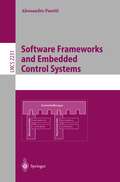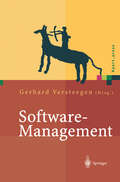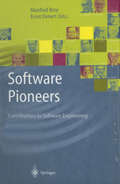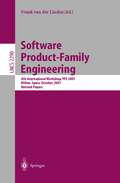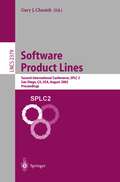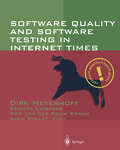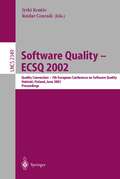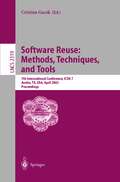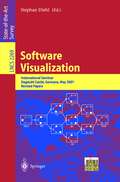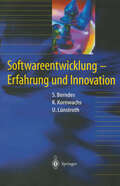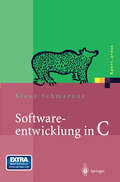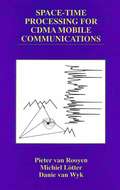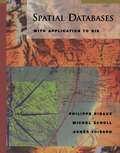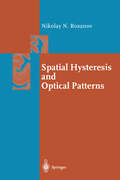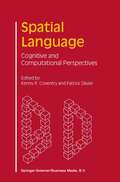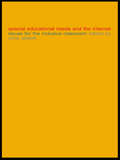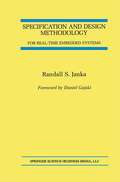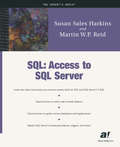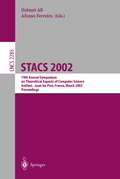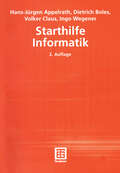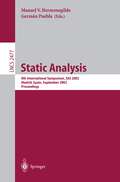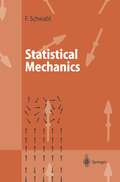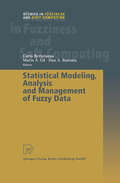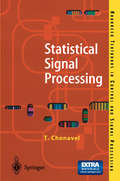- Table View
- List View
Software Frameworks and Embedded Control Systems (Lecture Notes in Computer Science #2231)
by Alessandro PasettiAlthough framework technology has proven its worth as a software reuse technique in many domains, there have been reservations regarding its application in embedded systems, mostly due to limited CPU and memory resources. Recent hardware advances, however, have changed this picture.This book shows how object-oriented software frameworks can be applied to embedded control systems. A case study of a framework using a set of application dependent design patterns for the orbit control system of satellites is presented.
Software Management: Beherrschung des Lifecycles (Xpert.press)
by A. Chughtai H. Dörnemann R. Heinold R. Hubert K. Salomon O. VogelSoftware Pioneers: Contributions to Software Engineering
by Manfred Broy Ernst DenertA lucid statement of the philosophy of modular programming can be found in a 1970 textbook on the design of system programs by Gouthier and Pont [1, l Cfl0. 23], which we quote below: A well-defined segmentation of the project effort ensures system modularity. Each task fonos a separate, distinct program module. At implementation time each module and its inputs and outputs are well-defined, there is no confusion in the intended interface with other system modules. At checkout time the in tegrity of the module is tested independently; there are few sche duling problems in synchronizing the completion of several tasks before checkout can begin. Finally, the system is maintained in modular fashion; system errors and deficiencies can be traced to specific system modules, thus limiting the scope of detailed error searching. Usually nothing is said about the criteria to be used in dividing the system into modules. This paper will discuss that issue and, by means of examples, suggest some criteria which can be used in decomposing a system into modules. A Brief Status Report The major advancement in the area of modular programming has been the development of coding techniques and assemblers which (1) allow one modu1e to be written with little knowledge of the code in another module, and (2) alJow modules to be reas sembled and replaced without reassembly of the whole system.
Software Product-Family Engineering: 4th International Workshop, PFE 2001 Bilbao, Spain, October 3-5, 2001 Revised Papers (Lecture Notes in Computer Science #2290)
by Frank Van Der LindenThis book contains the proceedings of the Fourth International Workshop on Product Family Engineering, PFE-4, held in Bilbao, Spain, October 3–5, 2001. This workshop was the fourth in a series started in 1996, with the same s- ject, software product-family engineering. Proceedings of the second and third workshops have been published as LNCS 1429 and LNCS 1951. The workshops were organized within co-operation projects of European - dustry, the ?rst two by ARES (Esprit IV 20.477) 1995–1999. This project had three industrial and three academic partners, and focused on software archit- turesforproductfamilies.SomeofthepartnerscontinuedinITEAproject99005, ESAPS(1999–2001).ITEAisthesoftwaredevelopmentprogram(?!2023)within the European Eureka initiative. ITEA projects last for two years and ESAPS ´ was succeeded by CAFE (ITEA ip00004), which started in 2001 and will t- minate in 2003. This workshop was initially prepared within ESAPS and the ´ preparation continued in CAFE. Due to the attacks in the USA of September 11, several people were not able to ?y and therefore did not show up. However, we have included their submissions in these proceedings. The session chair presented these submissions, and their inputs were used during the discussions. It was planned that Henk Obbink be workshop chair, and Linda Northrop and Sergio Bandinelli be co-chairs. However, because of personal circumstances Henk Obbink was not able to leave home during the workshop. Moreover both co-chairs had already enough other duties. Therefore the chairing duties were taken over by the program chair, Frank van der Linden.
Software Product Lines: Second International Conference, SPLC 2, San Diego, CA, USA, August 19-22, 2002. Proceedings (Lecture Notes in Computer Science #2379)
by Gary J. ChastekSoftware product lines are emerging as an important new paradigm for so- ware development. Product lines are enabling organizations to achieve impressive time-to-market gains and cost reductions. In 1997, we at the Software Engine- ing Institute (SEI) launched a Product Line Practice Initiative. Our vision was that product line development would be a low-risk, high-return proposition for the entire software engineering community. It was our hope from the beginning that there would eventually be su?cient interest to hold a conference. The First Software Product Line Conference (SPLC1) was the realization of that hope. Since SPLC1, we have seen a growing interest in software product lines. Companies are launching their own software product line initiatives, product line technical and business practices are maturing, product line tool vendors are emerging, and books on product lines are being published. Motivated by the enthusiastic response to SPLC1 and the increasing number of software product lines and product line researchers and practitioners, the SEI is proud to sponsor this second conference dedicated to software product lines. We were grati?ed by the submissions to SPLC2 from all parts of the globe, from government and commercial organizations. From these submissions we were able to assemble a rich and varied conference program with unique opportunities for software product line novices, experts, and those in between. This collection represents the papers selected from that response and includes research and experience reports.
Software Quality and Software Testing in Internet Times
by Dirk Meyerhoff Begoña Laibarra Rob van der Pouw Kraan Alan WalletThis publication deals with two major software quality management challenges. The first one involves how to deliver a software product within a competitive time frame and with a satisfying quality to the customer. The second one concerns how to best deal with the growing complexity of software applications using Internet technology. Due to faster development cycles the quality of an application has to be monitored during operation, since the usage of the application and the technology around it might change from day-to-day. The book compiles experiences from different industries and perspectives. Its goal is to give practical insights into high-tech software development projects of today.
Software Quality - ECSQ 2002: Quality Connection - 7th European Conference on Software Quality, Helsinki, Finland, June 9-13, 2002. Proceedings (Lecture Notes in Computer Science #2349)
by Jyrki Kontio Reidar ConradiSoftware professionals and companies live in a new world today. Increasingly complex systems need to be built faster and cheaper. While many of the est- lished approaches in software quality are still valid, the software quality c- munity is going through a paradigm shift that requires a re-assessment of our current method and tool portfolio, as well as creating new and more e?ective solutions. We have selected two themes for this conference to highlight this paradigm shift. Our ?rst theme, “production of attractive and reliable software at Internet speed” sums up the dilemma many software organisations face. In order to be competitive, software should contain advanced features and run reliably – yet it should be developed quickly and cost e?ectively for the right market window. Finding the right balance between these objectives is a critical question that will determine business success in the years to come. Our second theme, “production of software with a dynamic partnership n- work” highlights the current trend of using partnerships and subcontractors as integral players in the software development process. Partnerships sometimes need to be created quickly to respond to a market opportunity, yet the costs and speed of cooperation must be competitive. Di?erent companies have di?erent processes, quality tools and cultures, yet they should cooperate seamlessly for the best result.
Software Reuse: 7th International Conference, ICSR-7, Austin, TX, USA, April 15-19, 2002. Proceedings (Lecture Notes in Computer Science #2319)
by Cristina GacekAs a result of the open-source movement there is now a great deal of reusable software available in the public domain. This offers significant functionality that commercial software vendors can use in their software projects. Open-source approaches to software development have illustrated that complex, mission critical software can be developed by distributed teams of developers sharing a common goal. Commercial software vendors have an opportunity to both learn from the op- source community as well as leverage that knowledge for the benefit of its commercial clients. Nonetheless, the open-source movement is a diverse collection of ideas, knowledge, techniques, and solutions. As a result, it is far from clear how these approaches should be applied to commercial software engineering. This paper has looked at many of the dimensions of the open-source movement, and provided an analysis of the different opportunities available to commercial software vendors. References and Notes 1. It can be argued that the open-source community has produced really only two essential 9 products -- Apache (undeniably the most popular web server) and Linux although both are essentially reincarnations of prior systems. Both are also somewhat products of their times: Apache filled a hole in the then emerging Web, at a time no platform vendor really knew how to step in, and Linux filled a hole in the fragmented Unix market, colored by the community s general anger against Microsoft. 2.Evans Marketing Services, Linux Developers Survey, Volume 1, March 2000.
Software Visualization: International Seminar Dagstuhl Castle, Germany, May 20-25, 2001 Revised Lectures (Lecture Notes in Computer Science #2269)
by Stephan DiehlThis book presents the state of the art in software visualization and thus attempts to establish it as a field on its own. Based on a seminar held at Dagstuhl Castle in May 2001, the book offers topical sections on:- algorithm animation- software visualization and software engineering- software visualization and education- graphs in software visualization- and perspectives of software visualization.Each section starts with an introduction surveying previous and current work and providing extensive bibliographies.
Softwareentwicklung in C: Mit 14 Abbildungen und CD-ROM (Xpert.press)
by Klaus SchmaranzDieses Buch bietet sowohl eine anwendungsorientierte Einführung in die Programmiersprache C als auch eine moderne, strukturierte Herangehensweise an die Softwareentwicklung. Zahlreiche Beispiele werden zur Erläuterung angeführt, und der Weg von der Idee bis zur fertigen Software wird detailgenau mit allen Designentscheidungen erklärt. Das vermittelte Wissen stammt aus langjähriger Entwicklungspraxis des Autors, dementsprechend ist das Gelernte direkt in der Praxis einsetzbar. Die dem Buch beigegebene CD-ROM enthält alle Programme sowie die angesprochenen Tools.
Space-Time Processing for CDMA Mobile Communications (The Springer International Series in Engineering and Computer Science #544)
by Pieter van Rooyen Michiel P. Lötter Danie van WykSpace-Time Processing for CDMA Mobile Communications is one of the first books to: bring together spatial/temporal channel models and analytic performance evaluation techniques; establish a link between smart antenna systems and advanced receiver design techniques; treat smart antennas specifically for UMTS-like communication systems, with applicable simulations and calculations; supply code with Matlab® GUI so readers can run or modify existing simulations or create new ones. The field of smart antenna technology or, more generally, space-time processing is rapidly becoming one of the most promising areas of mobile communications, especially regarding the development of the first practical third-generation mobile communication systems. The authors have addressed many of the most basic questions relating to the use of space-time processing in CDMA-based third-generation systems and have presented models for the integration of space-time processing, error correction coding, and multi-user detection techniques. Included is extensive background information on cellular systems, antenna array theory, smart antenna techniques, performance of basic space-time processors and advanced space-time processors. The book also includes an extensive simulation program written in Matlab®. The simulation code implements both the uplink and the downlink of a UMTS-like communication system. This provides multiple options for simulating system performance using a variety of channel models as well as receiver structures. Space-Time Processing for CDMA Mobile Communications will be an invaluable reference work for engineers and researchers, and a useful source for design engineers enabling them to understand the implications of adding space-time processing systems to CDMA-based communication systems.
Spatial Databases: With Application to GIS (The Morgan Kaufmann Series in Data Management Systems)
by Philippe Rigaux Michel Scholl Agnès VoisardSpatial Databases is the first unified, in-depth treatment of special techniques for dealing with spatial data, particularly in the field of geographic information systems (GIS). This book surveys various techniques, such as spatial data models, algorithms, and indexing methods, developed to address specific features of spatial data that are not adequately handled by mainstream DBMS technology.The book also reviews commercial solutions to geographic data handling: ArcInfo, ArcView, and Smallworld GISs; and two extensions to the relational model, PostgreSQL and Oracle Spatial. The authors examine these underlying GIS technologies, assess their strengths and weaknesses, and consider specific uses for which each product is best suited.* Examines the strengths of various query languages and approaches to query processing.* Explains the use of computational geometry in spatial databases GISs, providing necessary background and an in-depth look at key algorithms.* Covers spatial access methods, including the R-tree and several space-driven structures, and is filled with dozens of helpful illustrations.
Spatial Hysteresis and Optical Patterns (Springer Series in Synergetics)
by Nikolay N. RosanovFrom the reviews: "This book is very well written and contains many important and new original results that certainly play an important role in today’s nonlinear optics." Physicalia
Spatial Language: Cognitive and Computational Perspectives
by Russell S. Harmon William W. DoePeople constantly talk to each other about experience or knowledge resulting from spatial perception; they describe the size, shape, orientation and position of objects using a wide range of spatial expressions. The semantic treatment of such expressions presents particular challenges for natural language processing. The meaning representation used must be capable of distinguishing between fine-grained sense differences and ambiguities grounded in our experience and perceptual structure. While there have been many different approaches to the representation and processing of spatial expressions, most computational characterisations have been restricted to particularly narrow problem domains. The chapters in the present volume reflect a commitment to the development of cognitively informed computational treatments of spatial language and spatial representation. Therefore the chapters present computational work, empirical work, or a combination of both. The book will appeal to all those interested in spatial language and spatial representation, whether they work in artificial intelligence, cognitive science, cognitive psychology or linguistics.
Special Educational Needs and the Internet: Issues for the Inclusive Classroom
by Chris AbbottWith Internet access for every school now a reality, teachers are beginning to explore the use of the Internet in the education of children with special needs. This book describes its benefits for children across the spectrum of special educational needs, from those with physical disabilities or sensory impairment to those with learning or social difficulties.With contributions from leading practitioners in the field, this book addresses the huge range of possibilities the Internet and associated technology offer for these pupils. Combining current theory and debate with practical guidance and inspiring case studies, this book considers:* how the Internet can be used to gather and publish information* how to communicate effectively through technology* policy and management issues for schools* the continuing challenges for access and inclusion.This book will be of interest to all teachers involved in special education needs, in both mainstream and special schools.
Special Educational Needs and the Internet: Issues for the Inclusive Classroom
by Chris AbbottWith Internet access for every school now a reality, teachers are beginning to explore the use of the Internet in the education of children with special needs. This book describes its benefits for children across the spectrum of special educational needs, from those with physical disabilities or sensory impairment to those with learning or social difficulties.With contributions from leading practitioners in the field, this book addresses the huge range of possibilities the Internet and associated technology offer for these pupils. Combining current theory and debate with practical guidance and inspiring case studies, this book considers:* how the Internet can be used to gather and publish information* how to communicate effectively through technology* policy and management issues for schools* the continuing challenges for access and inclusion.This book will be of interest to all teachers involved in special education needs, in both mainstream and special schools.
Specification and Design Methodology for Real-Time Embedded Systems
by Randall S. JankaSpecification and design methodology has seen significant growth as a research area over the last decade, tracking but lagging behind VLSI design technology in general and the CAD industry in particular. The commercial rush to market tries to leverage existing technology which fuels CAD design tool development. Paralleling this is very active basic and applied research to investigate and move forward rational and effective methodologies for accomplishing digital design, especially in the field of hardware/software codesign. It is this close relationship between industry and academia that makes close cooperation between researchers and practitioners so important-and monographs like this that combine both abstract concept and pragmatic implementation deftly bridge this often gaping chasm. It was at the IEEE/ACM Eighth International Symposium on Hardware/Software Codesign where I met the author of this monograph, Dr. Randall Janka, who was presenting some of his recent dissertation research results on specification and design methodology, or as he has so succinctly defined this sometimes ambiguous concept, "the tools and rules." Where so many codesign researchers are trying to prove out different aspects of codesign and using toy applications to do so, Dr. Janka had developed a complete specification and design methodology and prototyped the infrastructure-and proven its viability, utility, and effectiveness using a demanding real-world application of a real-time synthetic aperture radar imaging processor that was implemented with embedded parallel processors.
SQL: Access to SQL Server
by Susan Sales Harkins Martin ReidSQL: Access to SQL Server is more than just a comprehensive reference tool for Access developers. You'll also find efficient SQL solutions for common Access problems and tasks, as well as helpful hints and warnings about what to avoid. Learning Jet SQL is an important step from just using Access to developing with Access. In addition to learning Jet SQL, readers will embark on a journey into the world of SQL Server 2000. The journey starts when you learn how to install SQL Server and ends with an introduction to XML and ASP. Along the way, using Access Data Projects, you'll see features new to SQL Server 2000, including functions that return tables, instead of triggers and gotchas with upsizing. The authors highlight not only the enormous opportunities awaiting you as an Access developer, but also the potential challenges and pitfalls you may face as you move from Access to SQL Server 2000.
STACS 2002: 19th Annual Symposium on Theoretical Aspects of Computer Science, Antibes - Juan les Pins, France, March 14-16, 2002, Proceedings (Lecture Notes in Computer Science #2285)
by Helmut Alt Afonso FerreiraStarthilfe Informatik
by Hans-Jürgen Appelrath Dietrich Boles Volker Claus Ingo WegenerMit diesem Wissen sollte der Einstieg ins Informatikstudium problemlos gelingen. Die Starthilfe Informatik bringt dem Leser die zentralen Begriffe "Algorithmus" und "Datenstrukturen" bzgl. Darstellungsformen, Effizienz und Programmiermethodik nahe. Eine Einführung in die objektorientierte Softwareentwicklung und ein Überblick über Kerngebiete der Praktischen Informatik runden den Band ab.
Static Analysis: 9th International Symposium, SAS 2002, Madrid, Spain, September 17-20, 2002. Proceedings (Lecture Notes in Computer Science #2477)
by Manuel Hermenegildo German PueblaStatistical Mechanics (Advanced Texts in Physics)
by Franz SchwablThis unique and consistent mathematical treatise contains a deductive description of equilibrium statistics and thermodynamics. The most important elements of non-equilibrium phenomena are also treated. In addition to the fundamentals, the text tries to show how large the area of statistical mechanics is and how many applications can be found here. Modern areas such as renormalization group theory, percolation, stochastic equations of motion and their applications in critical dynamics, as well as fundamental thoughts of irreversibility are discussed. The text will be useful for advanced students in physics and other sciences who have profound knowledge of quantum mechanics.
Statistical Modeling, Analysis and Management of Fuzzy Data (Studies in Fuzziness and Soft Computing #87)
by Carlo Bertoluzza Maria A. Gil Dan A. RalescuThe contributions in this book state the complementary rather than competitive relationship between Probability and Fuzzy Set Theory and allow solutions to real life problems with suitable combinations of both theories.
Statistical Signal Processing: Modelling and Estimation (Advanced Textbooks in Control and Signal Processing)
by T. ChonavelThe only book on the subject at this level, this is a well written formalised and concise presentation of the basis of statistical signal processing. It teaches a wide variety of techniques, demonstrating how they can be applied to many different situations.
